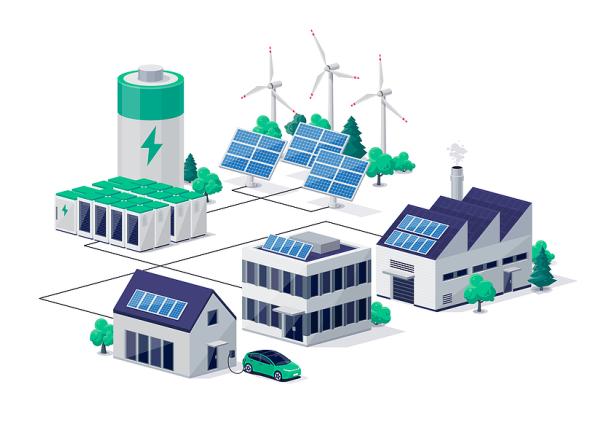The Distributed Generation (DG) market refers to the generation of electricity by small-scale power sources located close to the point of consumption. It involves decentralized power generation from various sources, such as solar photovoltaic (PV) systems, wind turbines, fuel cells, micro turbines, and reciprocating engines. Distributed Generation Market size will grow at approx. CAGR of 10.9% during the forecast period.Here is an overview of the Distributed Generation market, including its outlook, key factors, demand, and future forecasts:
Overview:
The Distributed Generation market has experienced significant growth in recent years due to several factors, including the increasing demand for electricity, the need for reliable and resilient power supply, advancements in technology, and supportive government policies. DG systems provide benefits such as reduced transmission and distribution losses, improved grid reliability, and the integration of renewable energy sources.
Outlook:
The outlook for the Distributed Generation market is positive. The transition towards cleaner and more sustainable energy systems, coupled with technological advancements, is driving the adoption of DG systems. Additionally, the growing need for energy access in remote areas and the increasing focus on energy security and grid resiliency are expected to contribute to the market’s growth.
Key Factors:
- Energy Transition and Renewable Integration: The shift towards a low-carbon economy and the integration of renewable energy sources are driving the adoption of DG systems. Distributed Generation allows for the efficient integration of solar PV, wind, and other renewable energy sources into the grid, reducing reliance on fossil fuels and lowering greenhouse gas emissions.
- Government Policies and Incentives: Supportive policies, regulations, and financial incentives play a crucial role in the growth of the Distributed Generation market. Governments worldwide are implementing feed-in tariffs, net metering, tax credits, and grants to encourage the installation of DG systems and promote renewable energy generation.
- Grid Resiliency and Energy Security: DG systems offer increased grid resiliency by providing localized power generation that is less susceptible to large-scale disruptions. They also enhance energy security by reducing dependence on centralized power plants and minimizing the risk of transmission and distribution system failures.
Demand:
- Decentralized Power Generation: DG systems allow for power generation at or near the point of consumption, reducing the need for long-distance transmission and distribution infrastructure. This is particularly beneficial in remote areas or locations with limited access to the grid.
- Renewable Energy Adoption: Distributed Generation facilitates the deployment of renewable energy sources, such as solar PV and wind, by providing localized power generation. As the demand for clean energy increases, so does the demand for DG systems.
- Energy Cost Savings: DG systems can help reduce energy costs by generating power onsite or near the point of consumption, avoiding transmission and distribution charges. This is especially attractive for commercial and industrial consumers looking to reduce electricity expenses.
Future Forecast:
The future of the Distributed Generation market looks promising. Market forecasts indicate a continued growth trajectory, driven by factors such as the increasing penetration of renewable energy, advancing technologies, supportive policies, and the need for a resilient and flexible electricity infrastructure.
We recommend referring our Stringent datalytics firm, industry publications, and websites that specialize in providing market reports. These sources often offer comprehensive analysis, market trends, growth forecasts, competitive landscape, and other valuable insights into this market.
By visiting our website or contacting us directly, you can explore the availability of specific reports related to this market. These reports often require a purchase or subscription, but we provide comprehensive and in-depth information that can be valuable for businesses, investors, and individuals interested in this market.
“Remember to look for recent reports to ensure you have the most current and relevant information.”
Click Here, To Get Free Sample Report: https://stringentdatalytics.com/sample-request/distributed-generation-(dg)-market/12512/
Market Segmentations:
Global Distributed Generation (DG) Market: By Company
• Alstom
• E.On. Se
• Caterpillar Power Plants
• Siemens Energy
• Doosan Fuel Cell America
• Ballard Power Systems
• General Electrical Power
• Sharp Corporation
• Enercon
• Bloom Energy
• Capstone Turbine Corporation
• Fuel Cell Energy
• Opra Turbines
• Rolls-Royce Power Systems
• Mitsubishi Hitachi Power Systems
Global Distributed Generation (DG) Market: By Type
• Solar Photovoltaic
• Wind Turbine
• Reciprocating Engines
• Micro Turbines
• Fuel Cells
Global Distributed Generation (DG) Market: By Application
• Residential
• Commercial
• Industrial
Global Distributed Generation (DG) Market: Regional Analysis
The regional analysis of the global Distributed Generation (DG) market provides insights into the market’s performance across different regions of the world. The analysis is based on recent and future trends and includes market forecast for the prediction period. The countries covered in the regional analysis of the Distributed Generation (DG) market report are as follows:
North America: The North America region includes the U.S., Canada, and Mexico. The U.S. is the largest market for Distributed Generation (DG) in this region, followed by Canada and Mexico. The market growth in this region is primarily driven by the presence of key market players and the increasing demand for the product.
Europe: The Europe region includes Germany, France, U.K., Russia, Italy, Spain, Turkey, Netherlands, Switzerland, Belgium, and Rest of Europe. Germany is the largest market for Distributed Generation (DG) in this region, followed by the U.K. and France. The market growth in this region is driven by the increasing demand for the product in the automotive and aerospace sectors.
Asia-Pacific: The Asia-Pacific region includes Singapore, Malaysia, Australia, Thailand, Indonesia, Philippines, China, Japan, India, South Korea, and Rest of Asia-Pacific. China is the largest market for Distributed Generation (DG) in this region, followed by Japan and India. The market growth in this region is driven by the increasing adoption of the product in various end-use industries, such as automotive, aerospace, and construction.
Middle East and Africa: The Middle East and Africa region includes Saudi Arabia, U.A.E, South Africa, Egypt, Israel, and Rest of Middle East and Africa. The market growth in this region is driven by the increasing demand for the product in the aerospace and defense sectors.
South America: The South America region includes Argentina, Brazil, and Rest of South America. Brazil is the largest market for Distributed Generation (DG) in this region, followed by Argentina. The market growth in this region is primarily driven by the increasing demand for the product in the automotive sector.
Visit Report Page for More Details: https://stringentdatalytics.com/reports/distributed-generation-(dg)-market/12512/
Reasons to Purchase Distributed Generation (DG) Market Report:
- Market Insights: A market report provides comprehensive insights into the current state of the consumer batteries market, including market size, trends, growth drivers, challenges, and opportunities.
- Industry Analysis: The report offers a detailed analysis of the consumer batteries industry, including technological advancements, competitive landscape, and key market players. This helps stakeholders understand the market dynamics and competition.
- Demand Assessment: The report provides a thorough assessment of the demand for consumer batteries, considering factors such as the increasing adoption of portable devices and the rising demand for reliable power sources.
- Market Forecasts: The report includes future forecasts and projections, offering valuable insights into the market’s expected growth and potential opportunities. This helps businesses plan their strategies and investments effectively.
- Competitive Intelligence: The report analyzes key market players, their market share, product portfolios, strategies, and recent developments. This information assists stakeholders in understanding the competitive landscape and making informed decisions.
- Technology Trends: The report highlights technological advancements in consumer batteries, such as improvements in energy density and charging time, helping businesses stay updated with the latest trends and innovations.
- Regulatory Landscape: A market report provides an analysis of the regulatory framework affecting the consumer batteries market, including policies related to safety, recycling, and environmental impact. This helps stakeholders navigate compliance requirements effectively.
- Investment Opportunities: By analyzing market trends and growth drivers, the report identifies potential investment opportunities in the consumer batteries sector. This helps investors make well-informed decisions and allocate resources effectively.
- Risk Assessment: The report assesses potential risks and challenges associated with consumer batteries, such as supply chain disruptions, competition, and regulatory changes. This allows stakeholders to mitigate risks and plan accordingly.
- Strategic Decision Making: Overall, purchasing a consumer batteries market report equips stakeholders with valuable information and insights to make informed decisions, identify growth opportunities, mitigate risks, and stay competitive in the evolving market.
About US:
Stringent Datalytics offers both custom and syndicated market research reports. Custom market research reports are tailored to a specific client’s needs and requirements. These reports provide unique insights into a particular industry or market segment and can help businesses make informed decisions about their strategies and operations.
Syndicated market research reports, on the other hand, are pre-existing reports that are available for purchase by multiple clients. These reports are often produced on a regular basis, such as annually or quarterly, and cover a broad range of industries and market segments. Syndicated reports provide clients with insights into industry trends, market sizes, and competitive landscapes. By offering both custom and syndicated reports, Stringent Datalytics can provide clients with a range of market research solutions that can be customized to their specific needs
Contact US:
Stringent Datalytics
Contact No – +1 346 666 6655
Email Id – sales@stringentdatalytics.com
Web – https://stringentdatalytics.com/




Leave a Reply